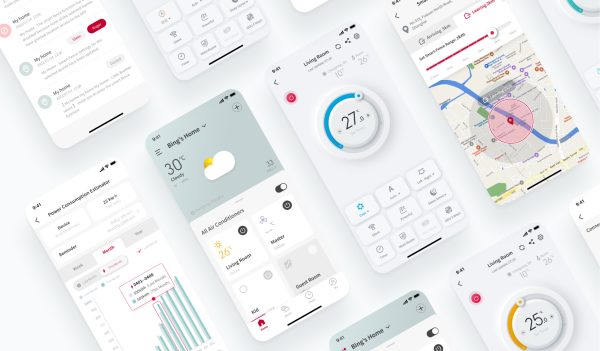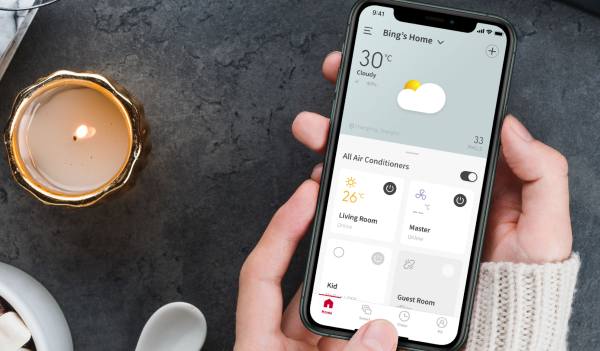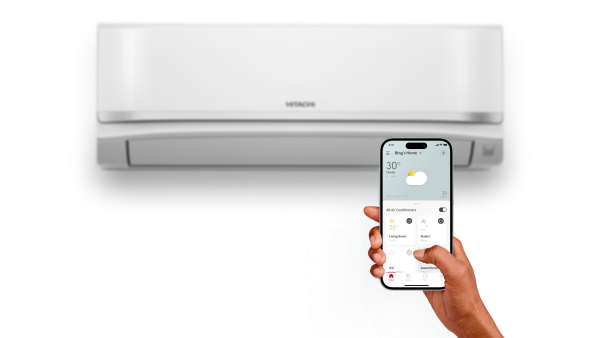Good product experience is more than just a collection of features
– Director of Product Design, Lawrence Chu, shares his view on the design of the airCloud Go app which won iF design award
- May. 31, 2024
- Residential Air Conditioning
- China
The airCloud Go app has been awarded the iF Design Award for its exceptional User Experience (UX) design. airCloud Go aims to revolutionize how users interact with their indoor environment. Crafted meticulously through extensive research, including mood boards, trend studies, and valuable insights from users and industry experts, our goal was to create an app that transcends mere functionality and delivers an intuitive, user-friendly experience. The awarded version of the airCloud Go app released in the People’s Republic of China, will be adopted globally soon.
In order to deep dive into the story behind the awarded design, we spoke to Lawrence Chu, Director of Product Design (UIUX & Industrial Design) at Johnson Controls-Hitachi Air Conditioning, who leads the airCloud Go app design.
Tell us about the awarded airCloud Go app and its key features.
Our previous air conditioner app, while functional, lacked the spark of surprise and delight that can elevate a user experience. We challenged ourselves: why should controlling your home comfort feel so mundane? This ignited a mission to create a truly engaging user journey. Our goal wasn’t just meeting basic needs (MVP), we wanted to create a memorable, playful, and intuitive experience that would make users smile and feel a connection with the app.
We understood that a good product experience is more than just a collection of features; it’s a holistic approach. This meant streamlining the onboarding process to significantly speed up login and get users up and running in seconds. We also embarked on a complete aesthetic overhaul, ensuring the app’s design resonated with our target customer segments. Finally, by integrating a wider range of compatible devices, we expanded our reach to serve a broader audience. Imagine cleaning and organizing your house – that’s what we did with the app’s information architecture. We reorganized the interface design to align with our brand language, making it user-friendly, visually appealing, and adaptable to a wider range of devices. To make it more fun and inviting, embedding micro-interactions, like weather widgets, because we understood the strong connection people have between weather and their desired air comfort through our research.

What was the biggest challenge to complete the design of airCloud Go, and how did you solve it?
One of the biggest challenges in developing airCloud Go was overcoming the initial mindset that a simple air conditioning app had reached its peak functionality. Our previous app worked well, but it lacked the user engagement and emotional connection we envisioned. This hurdle had two parts: internal resistance and understanding the user’s emotional connection with their air conditioner.
Internally, we had to challenge the assumption that an AC app couldn’t be more than utilitarian. We questioned ourselves: is this the best possible user experience we can create? This critical self-reflection pushed us to explore innovative design solutions and prioritize user engagement.
Externally, skepticism existed about the role of emotion in an air conditioning application. Traditionally, these apps focus purely on functionality. However, user research played a crucial role in overcoming this hurdle. It revealed a strong desire for a more engaging experience. We discovered that people don’t just want to control their air conditioner; they want to feel comfortable, relaxed, and in control of their environment. This insight forced us to redefine success and focus on creating a user experience that was not only functional but also delightful and catered to the user’s emotional well-being.
Tell us what you think is most important for UI/UX design.
In my opinion, the most important aspect of UI/UX design is empathy for the user. This translates into a deep understanding of the user’s needs, goals, and mental models. A successful design prioritizes the user throughout the entire design process. This means not just focusing on aesthetics or the latest trends, but on how users will interact with the product, what their pain points are, and how the design can address them effectively.
By practicing people-centered design, we can create products that are not only functional and usable but also intuitive, enjoyable, and even delightful to use. The airCloud Go app exemplifies this principle. Through extensive user research and testing, we were able to identify opportunities to simplify the user journey, improve discoverability of features, and create a more engaging experience that goes beyond basic control functionality.
 What originally motivated you to become a product designer?
What originally motivated you to become a product designer?
Many designers might stumble into the field, but for me, it was a deliberate choice. My background in design always fascinated me with the human experience side of things. However, it was becoming a product designer that truly ignited my passion for empathy. This field has challenged me to see the world through the user’s lens and care deeply about the problems they face. It’s a constant learning process, but with each solved problem, I feel like I’m making the world a slightly better place. The interesting thing is, design doesn’t just make me a better designer; it pushes me to be a better human being for others. That’s what truly motivates me: using design to create a more meaningful world, one thoughtful solution at a time.
What is your future vision on UI and UX design? Why do you have that vision?
My vision for the future of UI/UX design lies in two key areas: seamless integration with technology and a hyper-focus on personalization.
Seamless integration with technology will involve interfaces that become even more intuitive and responsive to user needs. Imagine an air conditioner app that automatically adjusts settings based on your location, preferences, and even real-time weather data. This level of integration would create a truly effortless user experience where the technology fades into the background and simply works for you.
Hyper-personalization is the other pillar of my vision. Imagine an app that learns your habits and anticipates your needs. An air conditioner app that knows your preferred sleep temperature and automatically adjusts the settings before bedtime, or one that suggests energy-saving settings based on your typical usage patterns. This level of personalization would create a user experience that feels truly tailored to you, enhancing your comfort and convenience even further.
The driving force behind this vision is the belief that UI/UX design has the potential to disappear into the background, be silent as promised by our Duality philosophy, becoming an energy of harmony that empowers us to interact with the world around us in a more meaningful way. We should strive to create interfaces that are so intuitive and people that they become an extension of ourselves, allowing us to focus on what truly matters.
These are just some of my thoughts on the future of UI/UX design. It’s an exciting field constantly evolving, and I’m eager to see how it continues to shape our interactions with technology in the years to come.

Lawrence Chu: Director of Product Design (UIUX & Industrial Design), Johnson Controls-Hitachi Air Conditioning
Lawrence is committed to design excellence and focuses on crafting digital and physical interactive product experiences that harmoniously blend business objectives, user needs, technological advancements, and environmental considerations.
Throughout his career as a designer and innovator, he has worked with companies small and large globally in various categories and in various roles. Lawrence Chu’s design journey has helped develop a broad portfolio of patented and proprietary design innovations that shaped the growth of companies in various B2B and B2C product categories. His design career has evolved in contributing to design from being a Principal Designer, to Design Management and a Design Educator. Since 2008, he has been imparting his knowledge and passion for design thinking and creative processes at the School of Design, Hong Kong Polytechnic University, where he also holds a Master of Innovation Design Strategies degree.
Lawrence Chu’s linkedin profile



